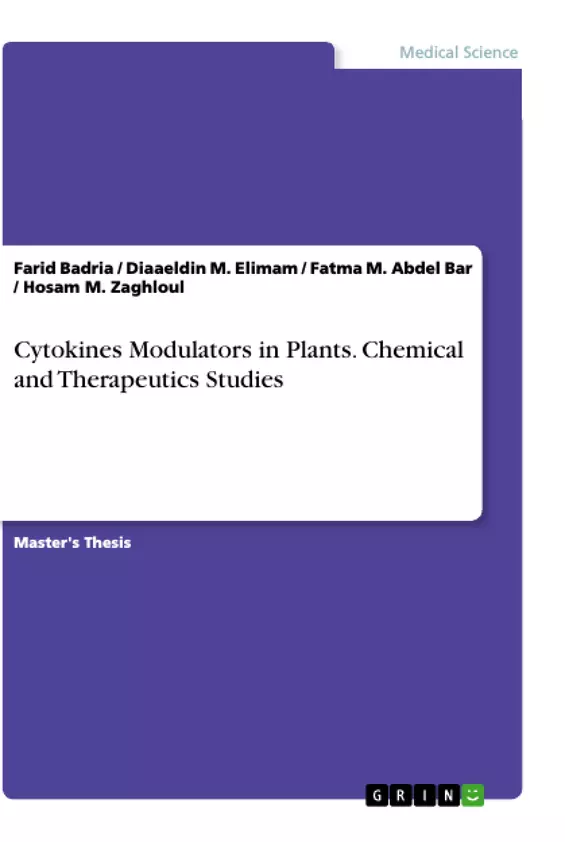The aim of the present study is (1) the screening group of plants that are traditionally used as immune-enhancers in an attempt to find the major fractions that are responsible for the activity of these plants and correlating them with already published studies. (2) The Modification of structure of the most active immunomodulatory component through semisynthetic derivatization reactions. The modifications will be made in pursuance of gaining a deeper insight of the structural requirements for immunomodulatory activity. (3) Testing the immunomodulatory activities of both natural and semisynthetic compounds. And (4) studying the mechanism of action of the active compounds as antioxidantand anti-proliferative.
Immunity is the body ability to identify and resist harmful pathogen. Metaphorically, the immunity is the body’s army that enables prevention as well as fighting of infectious diseasestoprotect self-tissues and organs from damage.
The immune system has a multi-layered construction with multiple defense stages. The skin is considered the first barrier of immunity. Then, physiological barriers take place, which are body physical conditions for examplepH and temperature that affordunsuitableenvironments for pathogens to live. Then, if a pathogen has escaped the first barriers and entered the body, it deals with innate immunity as well as acquired and/or adaptive immunity. Both systems consist of number of molecules and cells that interact in a complex manner to detect and eliminate any threat. Detection as well as elimination relay on bonding of immune cellular surface receptors as well as chemical binding to pathogens to trigger complex interaction of signaling of immune response.
Inhaltsverzeichnis (Table of Contents)
- Introduction
- Review of literature
- I- Immunomodulators
- II- Immunomodulatory plants
- III- Immunomodulatory natural products
- IV- Semisynthetic glycyrrhetinic acid derivatives
- VI- Conclusion
- Material and methods:
- Material
- Methods
- I- Plant material
- II- Biological assays
- III- Semisynthesis of 18-β-Glycyrrhetinic acid derivatives
- Results and discussion
- I- Extraction
- II- Fractionation
- III- Semisynthetic derivatization
- IV- Lymphocyte transformation assay
- IV- Other biological bioassays
- V- Isolation and semi-synthesis
- Summary and conclusion
- References
Zielsetzung und Themenschwerpunkte (Objectives and Key Themes)
This master thesis aims to explore the immunomodulatory potential of natural products and their semisynthetic derivatives. It investigates the effects of plant extracts and isolated compounds on lymphocyte transformation and other biological activities, focusing on the role of triterpenoids, particularly glycyrrhetinic acid and its derivatives.
- Immunomodulation by natural products
- Screening of immunomodulatory plant extracts
- Semisynthetic derivatization of glycyrrhetinic acid
- Biological evaluation of immunomodulatory activity
- Investigation of potential mechanisms of action
Zusammenfassung der Kapitel (Chapter Summaries)
The thesis begins with a comprehensive review of the literature on immunomodulatory agents, including their definitions, mechanisms of action, and testing methods. It then introduces the plant materials used in the study, including a list of selected plants and their traditional uses. The methods section details the procedures for extracting and fractionating plant materials, as well as the biological assays employed to assess immunomodulatory activity, including the lymphocyte transformation assay (LTA), antioxidant assay, and cytotoxicity assay.
The results and discussion section presents the findings of the study, focusing on the immunomodulatory activity of different plant extracts, their fractions, and glycyrrhetinic acid derivatives. It highlights the most active compounds and discusses their structural features in relation to their activity. The chapter also investigates the potential mechanisms of action of the compounds, including their antioxidant and cytotoxic properties. Finally, the thesis concludes by summarizing the key findings and discussing the potential of the investigated compounds as immunomodulators.
Schlüsselwörter (Keywords)
The main keywords and focus topics of this thesis include natural immunomodulators, plant extracts, triterpenoids, glycyrrhetinic acid, semisynthetic derivatives, lymphocyte transformation assay (LTA), antioxidant activity, cytotoxic activity, and potential mechanisms of action.
- Citation du texte
- Prof. Farid Badria (Auteur), Diaaeldin M. Elimam (Auteur), Fatma M. Abdel Bar (Auteur), Hosam M. Zaghloul (Auteur), 2016, Cytokines Modulators in Plants. Chemical and Therapeutics Studies, Munich, GRIN Verlag, https://www.grin.com/document/512548



